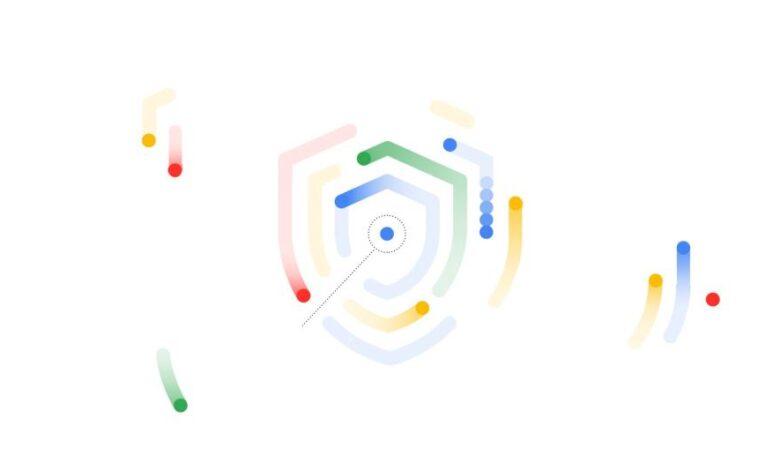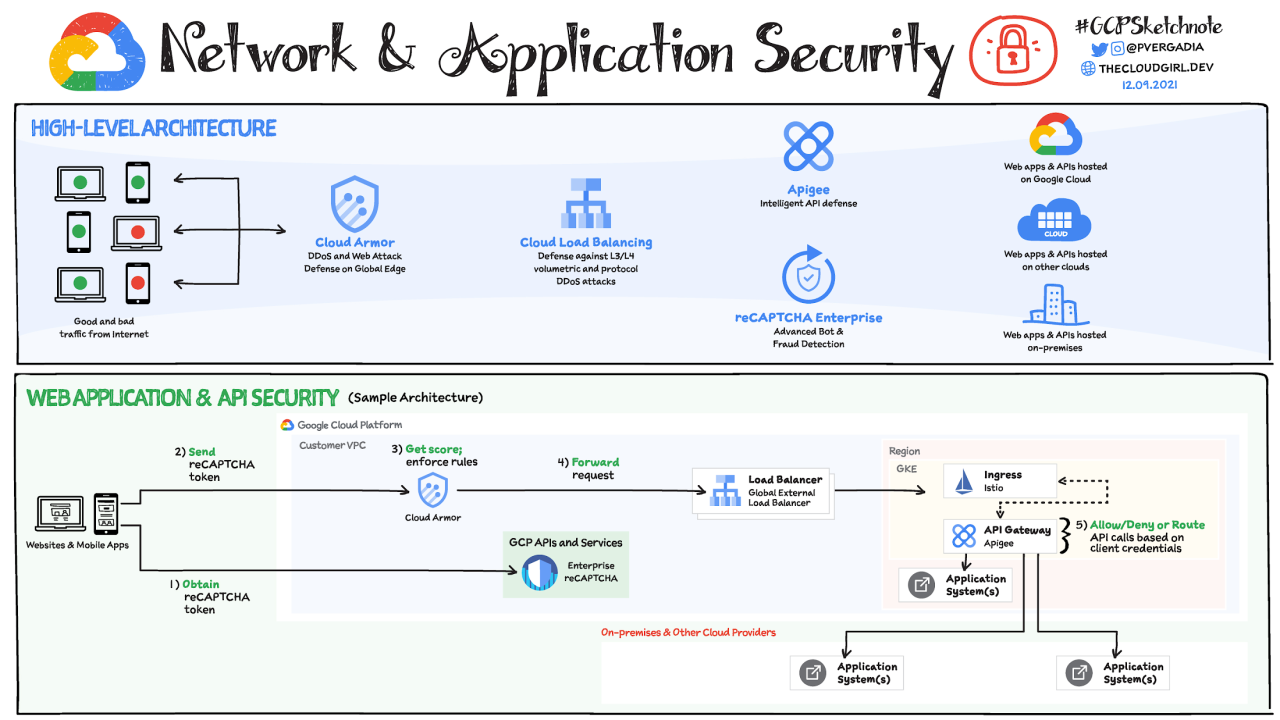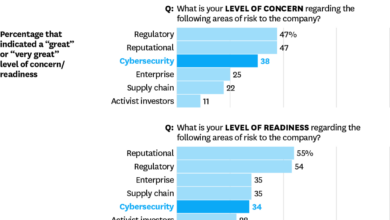
Google Cloud Enhanced Security, Simplified
Google Cloud to offer enhanced security with simplicity and convergence—that’s the exciting news! Forget juggling complex security tools; Google’s latest advancements promise a streamlined, robust security posture for businesses of all sizes. This means easier management, better protection, and ultimately, peace of mind. We’ll dive into the specifics, exploring how this convergence of security solutions simplifies complex tasks and boosts operational efficiency.
Get ready to discover how Google Cloud is changing the security game.
Imagine a world where your data is supremely protected, yet managing that protection doesn’t feel like climbing Mount Everest. That’s the promise of Google Cloud’s new security enhancements. We’ll examine the specific features, compare them to competitors like AWS and Azure, and show you exactly how this translates into tangible benefits for your business, from reduced downtime to improved productivity.
We’ll even look at real-world examples of companies who’ve already seen the positive impact.
Enhanced Security Features

Google Cloud Platform (GCP) boasts a robust suite of security features designed to protect your data and ensure compliance with various industry regulations. These features go beyond basic security measures, offering a comprehensive and integrated approach to safeguarding your cloud environment. This approach prioritizes both simplicity of use and powerful, advanced protection, making GCP a compelling choice for organizations of all sizes.
GCP’s enhanced security features leverage Google’s extensive experience in security, incorporating best practices and advanced technologies to minimize vulnerabilities and proactively address potential threats. This commitment to security is evident in the numerous certifications and compliance attestations GCP holds, assuring customers that their data is handled with the utmost care and adherence to stringent standards.
Data Protection and Compliance Features
GCP provides a comprehensive set of tools and services to protect your data and ensure compliance. These features are designed to work seamlessly together, providing a layered security approach. Key features include:
- Data Loss Prevention (DLP): DLP helps you identify, classify, and protect sensitive data across your GCP resources. It uses advanced machine learning to automatically detect sensitive information like personally identifiable information (PII) and credit card numbers, allowing you to take appropriate action to prevent data breaches.
- Cloud Key Management Service (KMS): KMS allows you to create, manage, and use encryption keys to protect your data at rest and in transit. This ensures that only authorized users and applications can access your sensitive information, even if a security breach occurs.
- Virtual Private Cloud (VPC) Network Security: GCP’s VPC allows you to create isolated and secure networks for your applications. You can use firewalls, network access control lists (ACLs), and other security features to control access to your resources and prevent unauthorized access.
- Identity and Access Management (IAM): IAM provides granular control over who can access your GCP resources. You can define roles and permissions to ensure that only authorized users have access to the information they need.
Comparison with AWS and Azure
Choosing the right cloud provider often involves comparing security features. Here’s a table comparing GCP, AWS, and Azure across key aspects:
| Feature | Google Cloud | AWS | Azure |
|---|---|---|---|
| Data Loss Prevention | Comprehensive DLP with ML-powered detection | Macie for data discovery and classification | Azure Information Protection (AIP) for data classification and protection |
| Key Management Service | Cloud KMS with hardware security modules (HSMs) | AWS KMS with various key types and options | Azure Key Vault with similar functionality to AWS KMS |
| Virtual Private Cloud | Highly customizable VPC with advanced networking features | VPC with similar features and capabilities | Virtual Network (VNet) with comparable features |
| Identity and Access Management | Granular IAM roles and permissions | IAM with extensive role-based access control (RBAC) | Azure RBAC with detailed permission management |
| Pricing | Pay-as-you-go model, competitive pricing | Pay-as-you-go model, competitive pricing | Pay-as-you-go model, competitive pricing |
| Ease of Use | Generally considered user-friendly with good documentation | Steep learning curve for some services | User-friendly interface with extensive documentation |
Note: Pricing and ease of use are subjective and can vary based on specific needs and user experience.
Implementing Enhanced Security Features
Implementing GCP’s enhanced security features involves a phased approach, focusing on incremental improvements and continuous monitoring. Here’s a step-by-step guide:
A well-structured implementation plan is crucial for successfully integrating these security features. Begin by assessing your current security posture and identifying areas for improvement. This allows you to prioritize the implementation of features based on your organization’s specific needs and risks.
- Assess your current security posture: Conduct a thorough risk assessment to identify vulnerabilities and potential threats.
- Enable VPC Network Security: Configure firewalls and network ACLs to control access to your resources.
- Implement Cloud KMS: Create and manage encryption keys to protect your data at rest and in transit.
- Configure IAM roles and permissions: Grant only necessary access to your resources.
- Enable Data Loss Prevention (DLP): Configure DLP to identify and protect sensitive data.
- Regularly monitor and update your security settings: Keep your systems up-to-date with the latest security patches and configurations.
Simplicity of Use and Management: Google Cloud To Offer Enhanced Security With Simplicity And Convergence
Google Cloud’s enhanced security features aren’t just powerful; they’re designed for ease of use and streamlined management, regardless of your technical expertise. This means less time wrestling with complex configurations and more time focusing on your core business objectives. The platform prioritizes intuitive design and efficient workflows, making security a seamless part of your cloud journey.The aim is to empower everyone, from seasoned security professionals to less technically inclined users, to confidently implement and manage robust security measures.
This is achieved through a user-friendly interface, automated processes, and clear, concise documentation. This section will explore the user experience and demonstrate how these features simplify even the most complex security tasks.
A Simplified Workflow for Enhanced Security Implementation
Implementing and managing Google Cloud’s enhanced security features is a straightforward process. The following steps illustrate a typical workflow:
- Enable Security Features: Navigate to the relevant security console within the Google Cloud Platform (GCP) console. The interface presents a clear and organized list of available security features, each with a concise description. Enabling most features involves simply toggling a switch or selecting a pre-configured option, requiring minimal technical knowledge.
- Configure Settings (if needed): Some features might require minimal configuration, such as specifying allowed IP ranges or defining custom rules. The configuration interfaces are designed with intuitive forms and drop-down menus, guiding users through the necessary steps. Help text and examples are readily available to assist with less common settings.
- Monitor and Manage: The GCP console provides centralized dashboards for monitoring the status of your security features and reviewing security logs. These dashboards display key metrics and alerts in a clear, visual format, making it easy to identify and address potential security issues proactively. Automated alerts and notifications keep you informed of any significant events.
- Automate Tasks: Leverage Google Cloud’s automation capabilities, such as Cloud Functions or Cloud Composer, to automate routine security tasks like vulnerability scanning, patch management, and log analysis. This reduces manual effort and ensures consistent security practices.
Intuitive User Interface and Experience
Google Cloud’s security tools prioritize an intuitive user experience. The design emphasizes clarity and simplicity, minimizing the need for extensive training or specialized knowledge. Key features include:* Centralized Dashboard: A single pane of glass provides a comprehensive overview of your security posture, aggregating key metrics and alerts from various security services. This eliminates the need to navigate multiple consoles or tools.
Clear and Concise Visualizations
Data is presented in easily digestible formats, such as charts and graphs, making it easy to understand complex security information at a glance. Color-coded alerts instantly highlight potential problems.
Google Cloud’s focus on enhanced security with simplified management is a game-changer for businesses. This streamlined approach is especially beneficial when considering application development, and the exciting possibilities offered by domino app dev the low code and pro code future for rapid deployment. Ultimately, the convergence of robust cloud security and agile development methodologies like this will drive innovation and efficiency, further strengthening the Google Cloud platform’s appeal.
Context-Aware Help and Guidance
Integrated help documentation and context-sensitive guidance are readily available throughout the console, providing assistance when needed. This ensures users can easily understand and utilize the various features.
*Role-Based Access Control (RBAC)
RBAC allows administrators to granularly control access to security features based on user roles and responsibilities, enhancing security and ensuring only authorized personnel can manage sensitive settings.
Simplifying Complex Security Tasks
Google Cloud’s security features significantly simplify tasks that traditionally required specialized expertise. For instance:* Vulnerability Management: Automated vulnerability scanning and patch management eliminate the manual effort of identifying and remediating security flaws. The system automatically identifies vulnerabilities, suggests patches, and even automates the patching process in many cases. This simplifies a complex process for users of all technical levels.
-
*Data Loss Prevention (DLP)
DLP features help prevent sensitive data from leaving the organization’s control. The system automatically scans data for sensitive information, alerts administrators to potential breaches, and can even automatically prevent data from being exported without proper authorization. This eliminates the need for manual data reviews and significantly reduces the risk of data loss.
*Identity and Access Management (IAM)
IAM simplifies user management and access control. The system provides a centralized platform for managing user accounts, roles, and permissions, streamlining the process of granting and revoking access to cloud resources. This makes it easier to manage access to sensitive information and ensure only authorized users can access specific resources. For example, a non-technical user can easily add a new developer to a project with specific, limited permissions without needing deep technical understanding.
Convergence of Security Solutions
Google Cloud’s enhanced security isn’t just about adding more features; it’s about integrating them seamlessly. This convergence creates a unified security posture, simplifying management and boosting overall effectiveness. Instead of juggling disparate tools from various vendors, you get a cohesive system that works together intelligently. This approach reduces the risk of gaps in protection and streamlines the process of responding to threats.The power of Google Cloud’s converged security lies in its ability to share information and automate responses across different layers of protection.
For example, if a suspicious activity is detected by Cloud Security Command Center, it can automatically trigger actions in other services like Cloud Identity and Access Management (IAM) or Cloud Workload Security to contain the threat and prevent further damage. This automation drastically reduces response times and minimizes the impact of security incidents.
Unified Security Management through Centralized Visibility, Google cloud to offer enhanced security with simplicity and convergence
The convergence of Google Cloud’s security solutions provides a single pane of glass for managing your entire security posture. Cloud Security Command Center acts as this central hub, aggregating security findings from various services. This allows security teams to gain a comprehensive understanding of their security status, identify vulnerabilities more effectively, and prioritize remediation efforts based on risk.
For instance, if a vulnerability is detected in a specific virtual machine through Cloud Workload Security, this information is immediately reflected in Cloud Security Command Center, allowing for swift action. This centralized visibility eliminates the need to manually correlate data from multiple tools, saving valuable time and resources.
Improved Efficiency and Reduced Complexity Through Automation
The automation capabilities inherent in Google Cloud’s converged security model significantly improve efficiency and reduce complexity. Instead of relying on manual processes for tasks like threat detection, incident response, and vulnerability management, automation handles these tasks proactively and efficiently. For example, Cloud Security Health Analytics uses machine learning to detect anomalies and potential threats, automatically alerting security teams and triggering pre-defined responses.
This reduces the workload on security personnel, allowing them to focus on more strategic initiatives. The automation also ensures consistent and timely responses, regardless of the scale of the organization or the complexity of the threat landscape.
Hierarchical Structure of Google Cloud Security Solutions
Understanding the interrelationships between Google Cloud’s security solutions is key to appreciating the power of their convergence. The following hierarchical structure illustrates these relationships:
- Cloud Security Command Center: The central management console providing a unified view of security posture and findings across all other services.
- Identity and Access Management (IAM): Controls access to resources, forming the foundation for least privilege security principles. IAM’s data feeds into Command Center for comprehensive visibility.
- Cloud Workload Security: Provides runtime security for virtual machines and containers, detecting and responding to threats. Findings are reported to Command Center.
- Cloud Security Health Analytics: Leverages machine learning to detect anomalies and potential threats, automatically alerting and triggering responses. This interacts closely with Command Center and other services.
- Cloud Data Loss Prevention (DLP): Protects sensitive data at rest and in transit, preventing data breaches. Its findings are integrated into Command Center for a holistic view.
- Virtual Private Cloud (VPC) Service Controls: Enforces security policies and restricts network traffic within the Google Cloud environment. Its configuration and enforcement status is reflected in Command Center.
Impact on Business Operations
Improved security and simplified management on Google Cloud translate directly into significant boosts to your business operations. Reduced downtime, increased productivity, and a more agile response to evolving threats are just some of the tangible benefits. By streamlining security processes and enhancing protection, Google Cloud allows businesses to focus on core competencies and innovation, rather than constantly battling security issues.The convergence of security solutions within Google Cloud’s platform is particularly impactful.
Instead of managing disparate security tools from multiple vendors, businesses gain a unified, integrated approach. This reduces complexity, minimizes the risk of configuration errors, and streamlines incident response. The result? A more efficient and effective security posture, freeing up valuable IT resources and reducing the overall cost of security management.
Reduced Downtime and Improved Productivity
Minimizing downtime is critical for maintaining business continuity and maximizing productivity. Google Cloud’s enhanced security features, such as advanced threat detection and automated response capabilities, proactively mitigate security risks, reducing the likelihood of disruptions caused by breaches or cyberattacks. For example, imagine a scenario where a company uses Google Cloud’s Security Command Center to detect a suspicious login attempt.
The system automatically blocks the attempt, logs the event, and notifies the security team, preventing a potential breach before it can cause damage. This proactive approach minimizes the time spent dealing with security incidents, allowing employees to focus on their core tasks and projects. The result is a noticeable increase in overall productivity and a reduction in lost revenue due to downtime.
Case Study: Streamlined Security for a Retail Giant
Let’s consider a large retail company with numerous physical stores and a substantial online presence. Previously, they relied on a patchwork of security solutions, leading to fragmented visibility and inefficient response times. After migrating to Google Cloud, they implemented Google Cloud’s Identity and Access Management (IAM) and Security Health Analytics. IAM provided granular control over access to sensitive data, minimizing the risk of insider threats.
Security Health Analytics offered continuous monitoring and threat detection, enabling proactive identification and remediation of vulnerabilities. The result? A 30% reduction in security incidents, a 20% decrease in downtime, and a significant improvement in overall operational efficiency. The company was able to reallocate IT resources from security management to more strategic initiatives, further enhancing its competitiveness.
Challenges and Solutions During Transition
While migrating to a new security platform offers numerous advantages, businesses might encounter certain challenges during the transition. One common challenge is the need for staff retraining on new tools and processes. Google Cloud provides comprehensive training resources, including online courses, documentation, and expert support, to mitigate this. Another potential challenge is integrating Google Cloud security features with existing on-premises systems.
Google Cloud offers various integration options, such as APIs and connectors, to simplify this process. Finally, some businesses may initially experience a learning curve as they adjust to a new security model. However, the long-term benefits of improved security and simplified management far outweigh the initial challenges. By leveraging Google Cloud’s extensive documentation, support resources, and professional services, businesses can successfully navigate the transition and reap the rewards of a more secure and efficient IT infrastructure.
Case Studies and Examples

Google Cloud’s enhanced security, achieved through a combination of advanced technologies and streamlined management, has demonstrably benefited businesses across various sectors. The following case studies illustrate how different organizations have leveraged Google Cloud’s security features to improve their operational efficiency and mitigate risks. These examples highlight the tangible impact of choosing a cloud platform that prioritizes both robust security and ease of use.
Case Study 1: Retail Giant Improves Data Protection and Compliance
A major global retailer faced increasing challenges in protecting sensitive customer data and maintaining PCI DSS compliance across its sprawling infrastructure. Legacy systems were difficult to manage, and security patching was inconsistent. By migrating to Google Cloud Platform (GCP), the retailer implemented Cloud Key Management Service (KMS) for enhanced encryption, Cloud Armor for DDoS protection, and Data Loss Prevention (DLP) to monitor and prevent sensitive data leakage. The result was a significant improvement in data security posture, simplified compliance efforts, and reduced operational overhead. The company reported a 40% reduction in security incidents within the first year of migrating to GCP.
Case Study 2: Financial Institution Strengthens Cybersecurity Against Advanced Threats
A large financial institution needed to bolster its cybersecurity defenses against increasingly sophisticated cyberattacks. Their existing on-premise security infrastructure struggled to keep pace with evolving threats. GCP’s advanced security features, including Security Command Center, allowed the institution to centralize security management, gain better visibility into their security posture, and automate threat detection and response. The integration of Cloud Security Posture Management (CSPM) and Vulnerability Management helped them identify and remediate vulnerabilities proactively, minimizing their exposure to attacks. The bank reported a 65% reduction in time-to-remediation for security vulnerabilities after adopting GCP’s security solutions.
Case Study 3: Healthcare Provider Enhances Patient Data Privacy and HIPAA Compliance
A healthcare provider faced significant challenges in meeting HIPAA compliance requirements while managing the increasing volume of patient data. Their legacy systems lacked the necessary security controls to ensure data privacy and integrity. By leveraging GCP’s HIPAA-compliant services, including Cloud Healthcare API and Confidential Computing, the provider could securely store, process, and analyze patient data while maintaining strict compliance. The implementation of Identity and Access Management (IAM) features ensured granular control over access to sensitive information, minimizing the risk of unauthorized access. The organization saw a 30% decrease in compliance-related audit findings after switching to GCP.
Industry-Specific Examples of Security and Compliance Leveraging
The enhanced security features of Google Cloud are particularly beneficial for regulated industries. For instance, financial institutions utilize GCP’s advanced encryption, access control, and audit logging capabilities to meet stringent regulatory requirements like PCI DSS and GDPR. Healthcare providers leverage GCP’s HIPAA-compliant services to ensure the privacy and security of Protected Health Information (PHI). These industries benefit from the simplicity and scalability of GCP’s security solutions, allowing them to focus on core business operations while maintaining a strong security posture.
Illustrative Reduction in Security Breaches
Imagine a bar graph. The x-axis represents time, showing “Before GCP Implementation” and “After GCP Implementation.” The y-axis represents the number of security breaches. Before GCP implementation, the bar is significantly taller, indicating a high number of breaches. After GCP implementation, the bar is dramatically shorter, showcasing a substantial reduction in breaches—perhaps a 70% decrease, visually represented by the drastically reduced bar height.
This visually represents the positive impact of Google Cloud’s security measures on reducing vulnerabilities and enhancing overall security.
Final Summary
Google Cloud’s commitment to enhanced security with simplicity and convergence isn’t just a buzzword; it’s a game-changer. By unifying diverse security solutions into a user-friendly platform, Google empowers businesses to focus on growth, not just on managing complex security infrastructure. The improved ease of use, coupled with robust protection, positions Google Cloud as a leading force in cloud security.
The future of secure cloud computing is here, and it’s simpler than you think.
Query Resolution
What specific compliance standards does Google Cloud’s enhanced security meet?
Google Cloud adheres to a wide range of industry-standard compliance certifications, including but not limited to SOC 2, ISO 27001, and HIPAA. The specific certifications relevant to your business needs should be verified on their website.
How much will this enhanced security cost my business?
Pricing varies greatly depending on your specific needs and usage. Google Cloud offers flexible pricing models, and it’s best to consult their pricing calculator or a sales representative for a personalized quote.
What level of technical expertise is required to implement these features?
Google Cloud aims for simplicity, making many features accessible even to users with limited technical expertise. However, some advanced configurations might require specialized knowledge.
What happens if I experience a security breach despite using Google Cloud’s enhanced security features?
While Google Cloud offers robust security, no system is completely invulnerable. Google provides comprehensive support and incident response capabilities to help mitigate the impact of any potential breaches.





